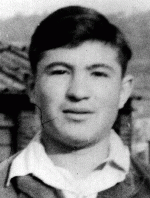
Wolf Himmelfarb
Born: June 19, 1927
Koprzewnica, Poland
Wolf was the eldest of three children born to Yiddish-speaking, religious Jewish parents in Koprzewnica, a small town in southern Poland. His father ran a grocery store, where his mother would help out on Thursdays. The store was located in the house of Wolf's grandmother, and Wolf, his brother, Izik, and sister, Chana, would play in a large yard in the back.
1933-39: Wolf started attending school a year late, at 8, so that he and his younger brother could share the same books. In the third grade, Jewish and non-Jewish children were separated. Wolf finished only four grades before the Germans invaded [Poland] in September 1939. He was on the street when German troops entered their town. They emptied all the homes and had everyone assemble in the central square. After about five hours, they let everyone go home.
1940-44: In February 1942 Koprzewnica's Jews were forced to move into a ghetto. That year, just before Wolf's 15th birthday, the Germans sent him to work at a munitions factory in Skarzysko [Kamienna]. Wolf, who had never seen electricity before, had to operate a fast-moving machine. His supervisor in Camp A, an elderly German who walked with a cane, shot any prisoner who looked tired. He would address his dog as a person and a prisoner as a dog. Pointing to a prisoner, he would say to the dog, "Man, take this dog."
Wolf was subsequently deported to camps in Czestochowa, Buchenwald and Schlieben before being liberated in Theresienstadt in May 1945. In 1950 he immigrated to America.